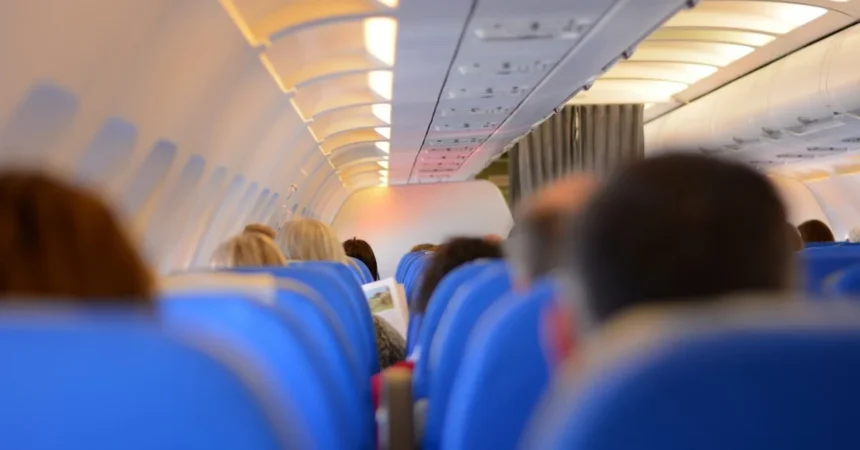On October 17, 2024, an Air India flight traveling from Frankfurt to New Delhi became the latest victim of a fake threat that rattled aviation security systems. This incident has raised fresh concerns over the increasing frequency of hoaxes that target commercial flights. With fake threats causing panic, delays, and huge financial losses, the situation brings to light the vulnerabilities of international travel and the urgent need for enhanced security measures.
The Incident Unfolds
Air India flight AI-121 was en route from Frankfurt to New Delhi when security authorities received a message indicating a potential threat to the aircraft. As soon as the warning was relayed, the crew was alerted, and emergency protocols were activated. The passengers were informed, and the aircraft prepared for an emergency landing at a designated location. After extensive checks and heightened security scrutiny, it was discovered that the threat was false.
Although no one was physically harmed, the incident caused significant distress to the passengers and crew. The plane, grounded for several hours, faced delays, inconveniencing travelers and causing economic ramifications for the airline. While hoaxes like these are often debunked, they still invoke fear and a loss of trust in the airline’s safety, and they divert critical security resources.
A Surge in Fake Threats
In recent years, fake threats targeting commercial airlines have become more frequent. These threats often manifest through anonymous calls or messages claiming that there is an explosive or some other form of security risk on board. Authorities are then forced to respond swiftly to minimize potential harm, often grounding flights or rerouting them to ensure the safety of passengers and crew.
This increase in fake threats stems from several factors, including malicious pranksters, political motives, and even attempts to distract security services from real criminal activities. Although they often lead to no tangible harm, their cumulative effect on airlines and passengers is profound. Each hoax costs airlines millions of dollars in emergency response measures, delays, and operational disruptions. More importantly, they erode public confidence in air travel safety.
Impact on the Aviation Industry
The financial repercussions of fake threats are significant. For airlines, the cost of diverting or delaying a flight is considerable. Planes must land at alternate airports, where resources must be mobilized to conduct security sweeps, and affected passengers must be rebooked on later flights. Additional expenses arise from the need to compensate passengers, conduct investigations, and repair any damage to the airline’s reputation.
From a broader perspective, fake threats can have a ripple effect on the global aviation industry. International flights are often closely coordinated to manage air traffic, airport schedules, and security protocols. When one flight is delayed or grounded, it can disrupt air traffic control plans, cause missed connections, and create widespread logistical complications. For an industry already dealing with thin profit margins and recovering from the impacts of the COVID-19 pandemic, the rise of fake threats poses a significant challenge.
Legal Ramifications
Perpetrators of fake threats targeting flights face severe legal consequences. In most jurisdictions, including India and the European Union, making false security threats is considered a serious offense. Those found guilty of orchestrating or participating in these hoaxes can be charged with terrorism-related offenses, which carry heavy penalties such as long prison sentences and significant fines.
However, tracking down the source of these threats can be difficult, as they are often delivered through untraceable communication methods. The anonymity of the internet has enabled pranksters and malicious actors to issue threats without fear of immediate repercussions. This creates a cat-and-mouse game between law enforcement agencies and perpetrators, with the former striving to develop new methods for identifying and prosecuting offenders.
Psychological Toll on Passengers
While the financial and operational consequences of fake threats are well-documented, the psychological toll on passengers cannot be overlooked. For many, the threat of an explosive device on board or other acts of violence is terrifying. Even after it is revealed to be a hoax, the experience of being subjected to such an event can cause lasting anxiety and trauma.
Passengers who endure such incidents often find it difficult to travel by air in the future, and some may avoid it altogether. This growing sense of fear among travelers undermines the confidence in air travel, potentially leading to a decline in air traffic. In a time when global mobility is increasingly vital for commerce and connectivity, such incidents challenge the very fabric of modern travel.
Strengthening Aviation Security
The increasing frequency of fake threats underscores the need for enhanced security measures within the aviation industry. In response to these growing risks, airports and airlines have implemented more stringent security protocols designed to identify and mitigate potential threats before they materialize.
Technological advancements have played a crucial role in strengthening aviation security. Sophisticated scanning equipment, biometric identification systems, and advanced data analytics have enabled authorities to more effectively screen passengers and cargo for potential dangers. Furthermore, real-time communication systems have allowed for faster and more coordinated responses to threats, minimizing the potential for harm.
However, the challenge remains in balancing security with convenience. Passengers already face lengthy security procedures, and further tightening these measures could result in significant delays and increased frustration. As such, the aviation industry is tasked with finding solutions that protect passengers without unduly burdening them.
The Role of International Cooperation
Addressing the issue of fake threats requires strong international cooperation. Air travel is inherently global, with planes crossing multiple borders and jurisdictions on a single flight. As such, individual countries cannot address the problem of fake threats in isolation. Collaborative efforts among international organizations, governments, and airlines are necessary to create standardized protocols for responding to threats.
The International Civil Aviation Organization (ICAO) plays a key role in facilitating such cooperation, providing guidelines and frameworks for addressing aviation security issues. Additionally, intelligence-sharing between countries can help identify patterns in fake threats, allowing authorities to take preemptive action against known perpetrators.
The Public’s Role in Aviation Security
While governments and airlines bear the primary responsibility for maintaining aviation security, the public also plays an important role. Passengers are encouraged to remain vigilant and report any suspicious activity to the authorities. By fostering a culture of alertness, the likelihood of a real threat going unnoticed decreases.
Education campaigns can help raise awareness among passengers about the importance of cooperation during security checks and the potential dangers of making false reports. Additionally, encouraging responsible use of communication platforms can help deter individuals from engaging in hoaxes or false alarms.
Long-Term Solutions to Fake Threats
To effectively address the issue of fake threats, a multi-pronged approach is required. First and foremost, law enforcement agencies must prioritize identifying and prosecuting individuals who make false threats. The legal consequences of such actions should be well-publicized to deter would-be perpetrators.
Additionally, investment in advanced security technologies is necessary to enhance the detection of real threats and reduce the operational disruptions caused by hoaxes. While it is impossible to eliminate all risks associated with air travel, advancements in surveillance and communication technologies can significantly reduce vulnerabilities.
Lastly, fostering a culture of international cooperation and information-sharing is crucial for combating the global nature of fake threats. Governments, airlines, and international organizations must work together to ensure that security protocols are robust and effective across borders.
The recent fake threat against Air India flight AI-121 from Frankfurt to New Delhi serves as a stark reminder of the vulnerabilities facing the aviation industry. While the incident was ultimately harmless, it highlights the growing challenge of fake threats and the significant consequences they carry for airlines, passengers, and governments.
Moving forward, the aviation industry must adopt a proactive approach to strengthening security measures, balancing the need for safety with the importance of maintaining efficient and convenient travel. Through technological innovation, international cooperation, and public engagement, the threat of fake alarms can be mitigated, allowing for a safer and more secure future for global air travel.
#AviationSecurity #AirIndia #FakeThreat #AirlineSafety #TravelSafety #AirlineSecurity







